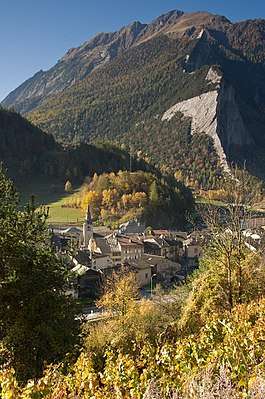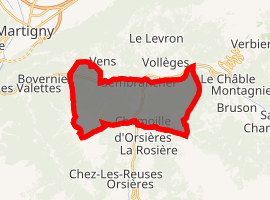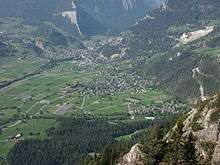Sembrancher
Sembrancher is a municipality in the district of Entremont in the canton of Valais in Switzerland.
Sembrancher | |
|---|---|
 | |
 Coat of arms | |
Location of Sembrancher 
| |
 Sembrancher  Sembrancher | |
| Coordinates: 46°5′N 7°9′E | |
| Country | Switzerland |
| Canton | Valais |
| District | Entremont |
| Government | |
| • Mayor | Bernard Giovanola |
| Area | |
| • Total | 17.7 km2 (6.8 sq mi) |
| Elevation | 717 m (2,352 ft) |
| Population (2018-12-31)[2] | |
| • Total | 1,042 |
| • Density | 59/km2 (150/sq mi) |
| Postal code | 1933 |
| SFOS number | 6035 |
| Surrounded by | Bagnes, Bovernier, Orsières, Vollèges |
| Twin towns | Saint-Laurent-des-Arbres (France) |
| Website | www SFSO statistics |
History
Sembrancher is first mentioned in 1177 as Sancti Pancratii de Branchi. Its German name St Branschier is no longer used.[3]
Geography

Sembrancher has an area, as of 2011, of 17.7 square kilometers (6.8 sq mi). Of this area, 17.5% is used for agricultural purposes, while 63.1% is forested. Of the rest of the land, 4.1% is settled (buildings or roads) and 15.3% is unproductive land.[4]
The municipality is the capital of the district of Entremont. It is located at the confluence of the Dranse de Bagnes and the Dranse d'Entremont along the road over the Great St Bernard Pass. It lies about 10 km (6.2 mi) distant from Verbier ski resort and Martigny.
Coat of arms
The blazon of the municipal coat of arms is Azure, in base Coupeaux Argent, issuant from sinister an Arm proper clad Vert and cuffed Argent holding a branch Or.[5]
Demographics
Sembrancher has a population (as of December 2018) of 1,042.[6] As of 2008, 9.3% of the population are resident foreign nationals.[7] Over the last 10 years (1999–2009 ) the population has changed at a rate of 3%. It has changed at a rate of 3% due to migration and at a rate of -0.4% due to births and deaths.[4]
Most of the population (as of 2000) speaks French (778 or 98.2%) as their first language, German is the second most common (6 or 0.8%) and Italian is the third (4 or 0.5%).[8]
As of 2008, the gender distribution of the population was 50.1% male and 49.9% female. The population was made up of 369 Swiss men (43.7% of the population) and 54 (6.4%) non-Swiss men. There were 381 Swiss women (45.1%) and 41 (4.9%) non-Swiss women.[9] Of the population in the municipality 491 or about 62.0% were born in Sembrancher and lived there in 2000. There were 190 or 24.0% who were born in the same canton, while 73 or 9.2% were born somewhere else in Switzerland, and 36 or 4.5% were born outside of Switzerland.[8]
The age distribution of the population (as of 2000) is children and teenagers (0–19 years old) make up 28.8% of the population, while adults (20–64 years old) make up 53.2% and seniors (over 64 years old) make up 18.1%.[4]
As of 2000, there were 347 people who were single and never married in the municipality. There were 367 married individuals, 52 widows or widowers and 26 individuals who are divorced.[8]
As of 2000, there were 299 private households in the municipality, and an average of 2.6 persons per household.[4] There were 98 households that consist of only one person and 40 households with five or more people. Out of a total of 307 households that answered this question, 31.9% were households made up of just one person and there were 3 adults who lived with their parents. Of the rest of the households, there are 63 married couples without children, 120 married couples with children There were 10 single parents with a child or children. There were 5 households that were made up of unrelated people and 8 households that were made up of some sort of institution or another collective housing.[8]
In 2000 there were 171 single family homes (or 67.3% of the total) out of a total of 254 inhabited buildings. There were 62 multi-family buildings (24.4%), along with 11 multi-purpose buildings that were mostly used for housing (4.3%) and 10 other use buildings (commercial or industrial) that also had some housing (3.9%).[10]
In 2000, a total of 279 apartments (74.4% of the total) were permanently occupied, while 75 apartments (20.0%) were seasonally occupied and 21 apartments (5.6%) were empty.[10] As of 2009, the construction rate of new housing units was 2.4 new units per 1000 residents.[4] The vacancy rate for the municipality, in 2010, was 0.75%.[4]
|
|
| ||||||||||||||||||||||||||||||||||||||||||||||||||||||||||||
| Source: [3][11] | ||||||||||||||||||||||||||||||||||||||||||||||||||||||||||||||
Sights
The entire small city of Sembrancher is designated as part of the Inventory of Swiss Heritage Sites[12]
Politics
In the 2007 federal election the most popular party was the CVP which received 47.64% of the vote. The next three most popular parties were the FDP (21.05%), the SVP (17.15%) and the SP (9.05%). In the federal election, a total of 390 votes were cast, and the voter turnout was 62.7%.[13]
In the 2009 Conseil d'Etat/Staatsrat election a total of 390 votes were cast, of which 14 or about 3.6% were invalid. The voter participation was 64.8%, which is much more than the cantonal average of 54.67%.[14] In the 2007 Swiss Council of States election a total of 382 votes were cast, of which 29 or about 7.6% were invalid. The voter participation was 63.3%, which is similar to the cantonal average of 59.88%.[15]
Economy
Its spring water has a high florine content and is sold as 'Sembrancher'.
As of 2010, Sembrancher had an unemployment rate of 5.3%. As of 2008, there were 36 people employed in the primary economic sector and about 18 businesses involved in this sector. 138 people were employed in the secondary sector and there were 19 businesses in this sector. 129 people were employed in the tertiary sector, with 26 businesses in this sector.[4] There were 342 residents of the municipality who were employed in some capacity, of which females made up 35.4% of the workforce.
In 2008 the total number of full-time equivalent jobs was 244. The number of jobs in the primary sector was 20, all of which were in agriculture. The number of jobs in the secondary sector was 128 of which 93 or (72.7%) were in manufacturing and 33 (25.8%) were in construction. The number of jobs in the tertiary sector was 96. In the tertiary sector; 35 or 36.5% were in wholesale or retail sales or the repair of motor vehicles, 3 or 3.1% were in the movement and storage of goods, 9 or 9.4% were in a hotel or restaurant, 3 or 3.1% were the insurance or financial industry, 8 or 8.3% were technical professionals or scientists, 6 or 6.3% were in education and 23 or 24.0% were in health care.[16]
In 2000, there were 163 workers who commuted into the municipality and 220 workers who commuted away. The municipality is a net exporter of workers, with about 1.3 workers leaving the municipality for every one entering.[17] Of the working population, 10.2% used public transportation to get to work, and 72.8% used a private car.[4]
Religion
From the 2000 census, 705 or 89.0% were Roman Catholic, while 29 or 3.7% belonged to the Swiss Reformed Church. Of the rest of the population, there was 1 individual who belongs to another Christian church. There were 3 (or about 0.38% of the population) who were Islamic. There were 1 individual who belonged to another church. 49 (or about 6.19% of the population) belonged to no church, are agnostic or atheist, and 4 individuals (or about 0.51% of the population) did not answer the question.[8]
Education
In Sembrancher about 258 or (32.6%) of the population have completed non-mandatory upper secondary education, and 48 or (6.1%) have completed additional higher education (either university or a Fachhochschule). Of the 48 who completed tertiary schooling, 83.3% were Swiss men, 14.6% were Swiss women.[8]
As of 2000, there were 55 students from Sembrancher who attended schools outside the municipality.[17]
References
- "Arealstatistik Standard - Gemeinden nach 4 Hauptbereichen". Federal Statistical Office. Retrieved 13 January 2019.
- "Ständige Wohnbevölkerung nach Staatsangehörigkeitskategorie Geschlecht und Gemeinde; Provisorische Jahresergebnisse; 2018". Federal Statistical Office. 9 April 2019. Retrieved 11 April 2019.
- Sembrancher in German, French and Italian in the online Historical Dictionary of Switzerland.
- Swiss Federal Statistical Office accessed 06-September-2011
- Flags of the World.com accessed 06-September-2011
- Swiss Federal Statistical Office - STAT-TAB, online database – Ständige und nichtständige Wohnbevölkerung nach institutionellen Gliederungen, Geburtsort und Staatsangehörigkeit (in German) accessed 23 September 2019
- Swiss Federal Statistical Office - Superweb database - Gemeinde Statistics 1981-2008 (in German) accessed 19 June 2010
- STAT-TAB Datenwürfel für Thema 40.3 - 2000 Archived 2013-08-09 at the Wayback Machine (in German) accessed 2 February 2011
- Ständige Wohnbevolkerung nach Geschlecht und Heimat am 31.12.2009.xls (in German and French) accessed 24 August 2011
- Swiss Federal Statistical Office STAT-TAB - Datenwürfel für Thema 09.2 - Gebäude und Wohnungen Archived 2014-09-07 at the Wayback Machine (in German) accessed 28 January 2011
- Swiss Federal Statistical Office STAT-TAB Bevölkerungsentwicklung nach Region, 1850-2000 Archived 2014-09-30 at the Wayback Machine (in German) accessed 29 January 2011
- "Kantonsliste A-Objekte". KGS Inventar (in German). Federal Office of Civil Protection. 2009. Archived from the original on 28 June 2010. Retrieved 25 April 2011.
- Swiss Federal Statistical Office, Nationalratswahlen 2007: Stärke der Parteien und Wahlbeteiligung, nach Gemeinden/Bezirk/Canton (in German) accessed 28 May 2010
- Staatsratswahlen vom 1. März 2009 (in German) accessed 24 August 2011
- Ständeratswahl 2007 (in German) accessed 24 August 2011
- Swiss Federal Statistical Office STAT-TAB Betriebszählung: Arbeitsstätten nach Gemeinde und NOGA 2008 (Abschnitte), Sektoren 1-3 Archived 2014-12-25 at the Wayback Machine (in German) accessed 28 January 2011
- Swiss Federal Statistical Office - Statweb Archived 2012-08-04 at Archive.today (in German) accessed 24 June 2010